
Cordyline australis, commonly known as the cabbage tree, or by its Māori name of tī or tī kōuka, is a widely branched monocot tree endemic to New Zealand.

Dichondra is a small genus of flowering plants in the morning glory family, Convolvulaceae. They are prostrate, perennial, herbaceous plants, with creeping stems which take root readily at the leaf nodes. The flowers are white, greenish or yellowish, 2–3 mm (0.079–0.118 in) diameter. Members of the genus are commonly known as ponysfoots and are native to tropical and cool temperate regions around the world.

Muehlenbeckia or maidenhair is a genus of flowering plants in the family Polygonaceae. It is native to the borders of the Pacific, including South and North America, Papua New Guinea and Australasia. It has been introduced elsewhere, including Europe. Species vary in their growth habits, many being vines or shrubs. In some environments, rampant species can become weedy and difficult to eradicate.

Araujia sericifera is a perennial vining plant in the genus Araujia, of the family Apocynaceae, that is native to South America. The species was described in 1817 by the Portuguese botanist Félix de Avelar Brotero. The synonym Araujia hortorum is in more frequent use in New Zealand. Its common names include bladderflower, white bladderflower, bladder vine, cruel vine, cruel plant, moth plant, moth vine, common moth vine, and false choko.
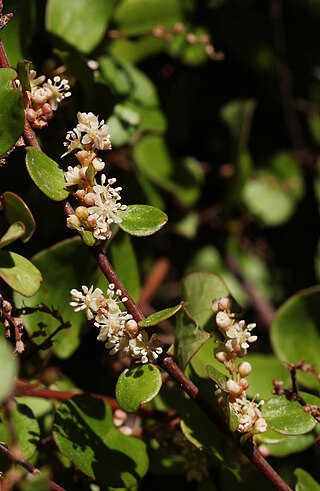
Muehlenbeckia complexa is a plant commonly known as pohuehue, although this name also applies to some other climbers such as Muehlenbeckia australis.
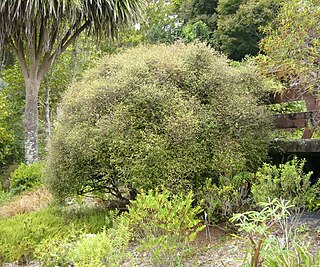
Muehlenbeckia astonii, commonly known as the shrubby tororaro, is an endemic New Zealand shrub in the family Polygonaceae. It is found in both, the North and the South Islands. It has distinctive small heart-shaped deciduous leaves amidst a tangle of wiry interlocking branches. Although common in cultivation around the world, it is extremely rare and threatened in the wild. Its consercation status is "Nationally Endangered".

Muehlenbeckia platyclada, known as centipede plant, tapeworm plant or ribbonbush, is a species of plant in the knotweed family from New Guinea and the Solomon Islands. It is also naturalized in other tropical regions, including Puerto Rico, India, Bolivia, Madagascar, Nicaragua and Pakistan.

Juncus acutus, the spiny rush, sharp rush or sharp-pointed rush, is a flowering plant in the monocot family Juncaceae. It is native to the Americas, Northern and Southern Africa, Western and Southern Europe and West Asia, and is found in a variety of wet habitats, such as bogs, fens, meadows, and salt marshes, and along the edges of ponds and lakes.

Declana floccosa, the forest semilooper or manuka moth is a moth of the family Geometridae. It is endemic to New Zealand. It was first described by Francis Walker in 1863 using specimens obtained from Colonel Bolton.
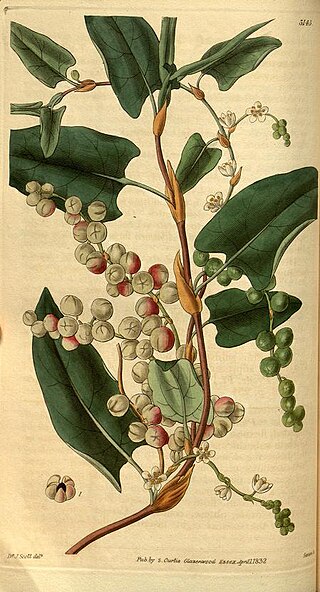
Muehlenbeckia adpressa, commonly known as climbing lignum, is a prostrate or climbing plant, native to Australia. It has thin red-brown stems up to 1 metre in length. The leaves are 1.5–6 centimetres (0.59–2.36 in) long and 1.5–3.5 centimetres (0.59–1.38 in) wide. It occurs in coastal areas of Western Australia, South Australia, Tasmania, Victoria and New South Wales.

Wahlenbergia gracilis, commonly known as Australian bluebell or sprawling bluebell is a perennial tufted herb from the family Campanulaceae. The species is widespread throughout Australia. The species is not considered at risk.
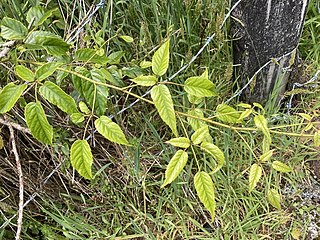
Rubus cissoides, commonly called bush lawyer or tātarāmoa in te reo Māori, is a species of flowering plant in the family Rosaceae, endemic to New Zealand. Alan Cunningham described R. cissoides in 1839. Plants of this species of are perennial scrambling vines with compound leaves with 3-5 leaflets each up to 15 cm long, reddish prickles on the branches, white flowers from September to November and red berries from December to April. The conservation status of R. cissoides is Not Threatened, it is widespread on all three main islands of mainland New Zealand, and it has been used by Māori as food, medicines and construction materials.

Muehlenbeckia axillaris is a low evergreen shrub, forming wiry mats up to about 1 metre in diameter, native to New Zealand, and the Australian states of Tasmania, New South Wales and Victoria. It has thin, red-brown stems, with glossy squarish to roundish leaves that are less than 1 cm (0.39 in) in diameter and 2–4 mm (0.079–0.157 in) thick. Flowers are inconspicuous, yellowish-white, 4–8 mm (0.16–0.31 in) in diameter, and borne in groups of up to three in the axils. The fruit is black, shiny, and up to 3.5 mm (0.14 in) long, produced in late summer to fall.

Duma florulenta, commonly known as tangled lignum or often simply lignum, is a plant native to inland Australia. It is associated with wetland habitats, especially those in arid and semiarid regions subject to cycles of intermittent flooding and drying out. The Wiradjuri name for the plant is gweeargal, and the Walmajarri name is Kirinykiriny, or Kurinykuriny.
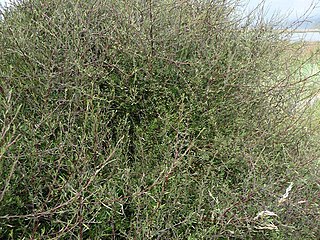
Plagianthus divaricatus or saltmarsh ribbonwood is a plant that is endemic to New Zealand. The Māori name is makaka. Other common names it is known by marsh ribbonwood, Houi and Runa.

Muehlenbeckia ephedroides, the leafless pohuehue or leafless muehlenbeckia, is a prostrate or climbing plant native to New Zealand.

Clitarchus tepaki is a stick insect that belongs to the common New Zealand genus Clitarchus. It is endemic to the North Cape area of New Zealand, in particular Te Paki and the Karikari Peninsula.

Reynoutria is a genus of flowering plants in the Polygonaceae, also known as the knotweed or buckwheat family. The genus is native to eastern China, Eastern Asia and the Russian Far East, although species have been introduced to Europe and North America. Members of the genus, including R. japonica and its hybrid with R. sachalinensis, are highly invasive plants.

Duma is a genus of shrubby flowering plants in the family Polygonaceae, subfamily Polygonoideae. The genus was separated from Muehlenbeckia in 2011. The native range of the genus is Australia.
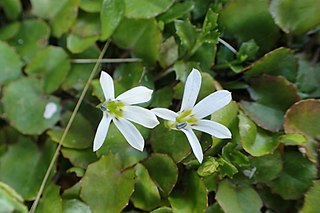
Lobelia angulata, previously known as Pratia angulata, and commonly known as pānakenake, or Lawn Lobelia is a small scrambling herbaceous plant native to New Zealand.




















